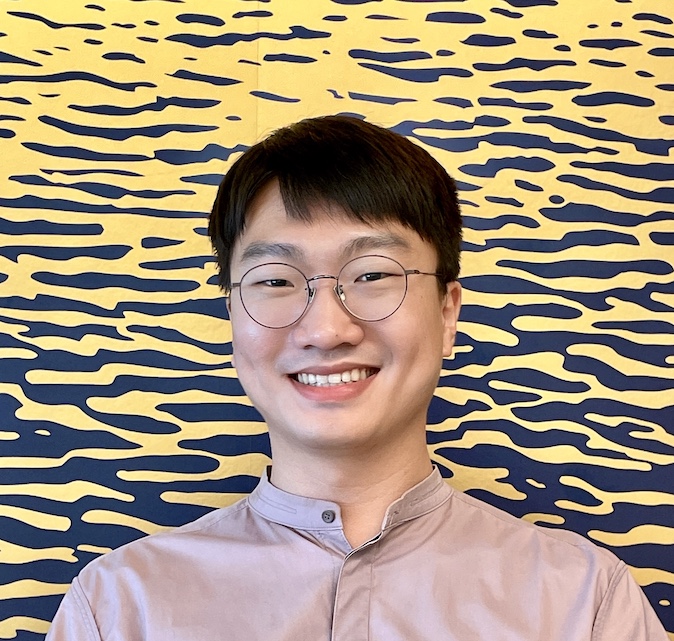
| CV | Google Scholar | LinkedIn | |
I am currently a postdoctoral scholar in Electrical Engineering and Computer Science
at University of Michigan and an affiliated researcher at UC Berkeley/ICSI advised by Prof. Stella X. Yu.
|

University of Michigan |
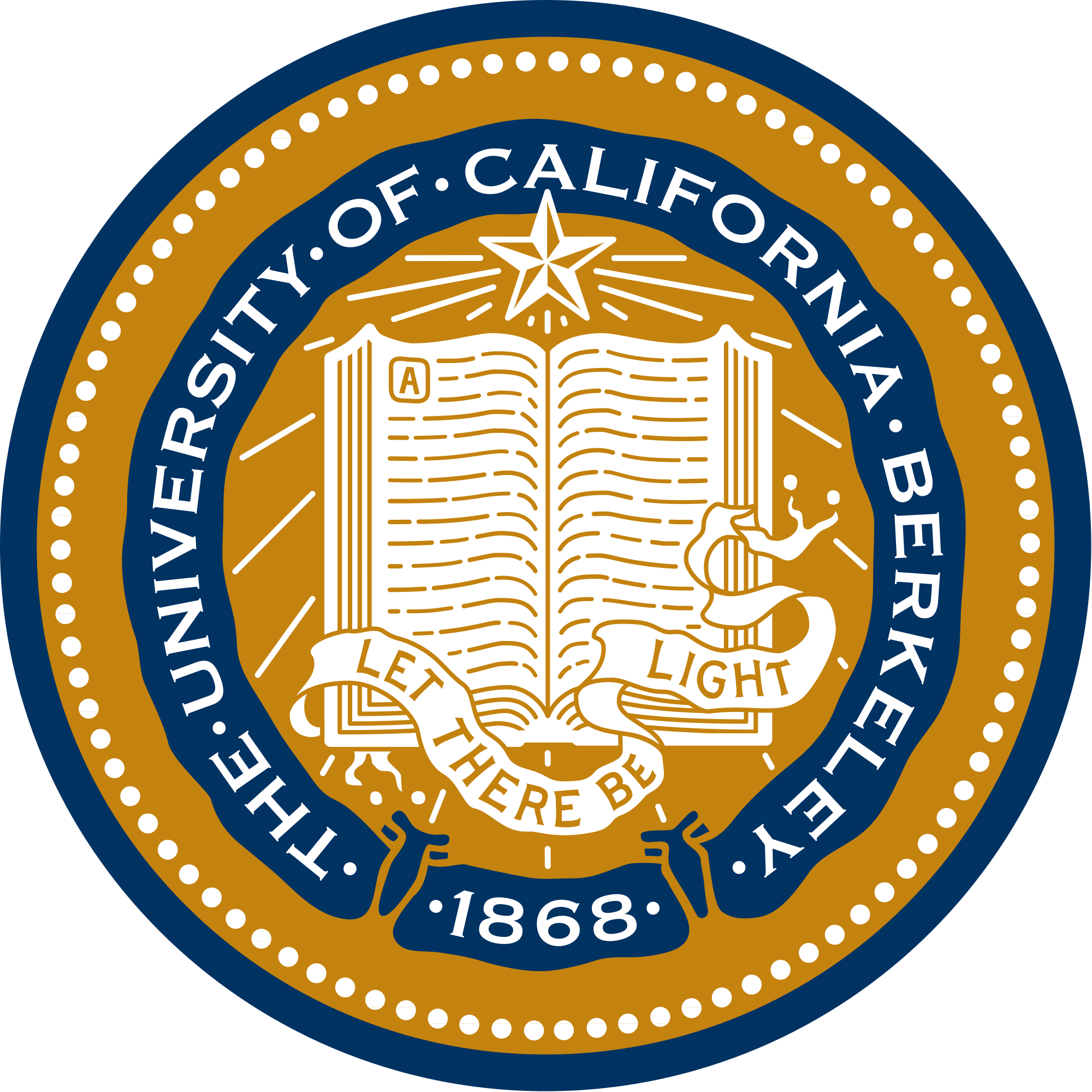
UC Berkeley/ICSI |

Adobe research |
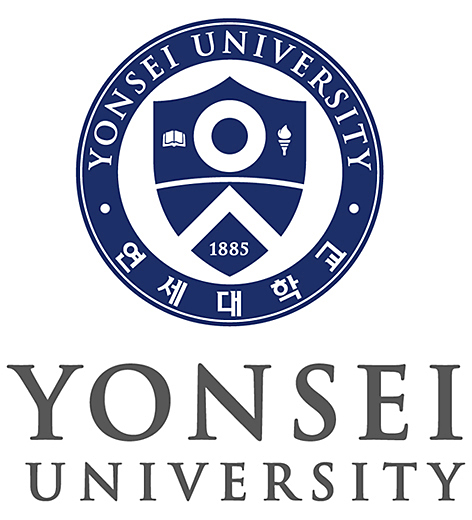
Yonsei university |
|---|
|
|
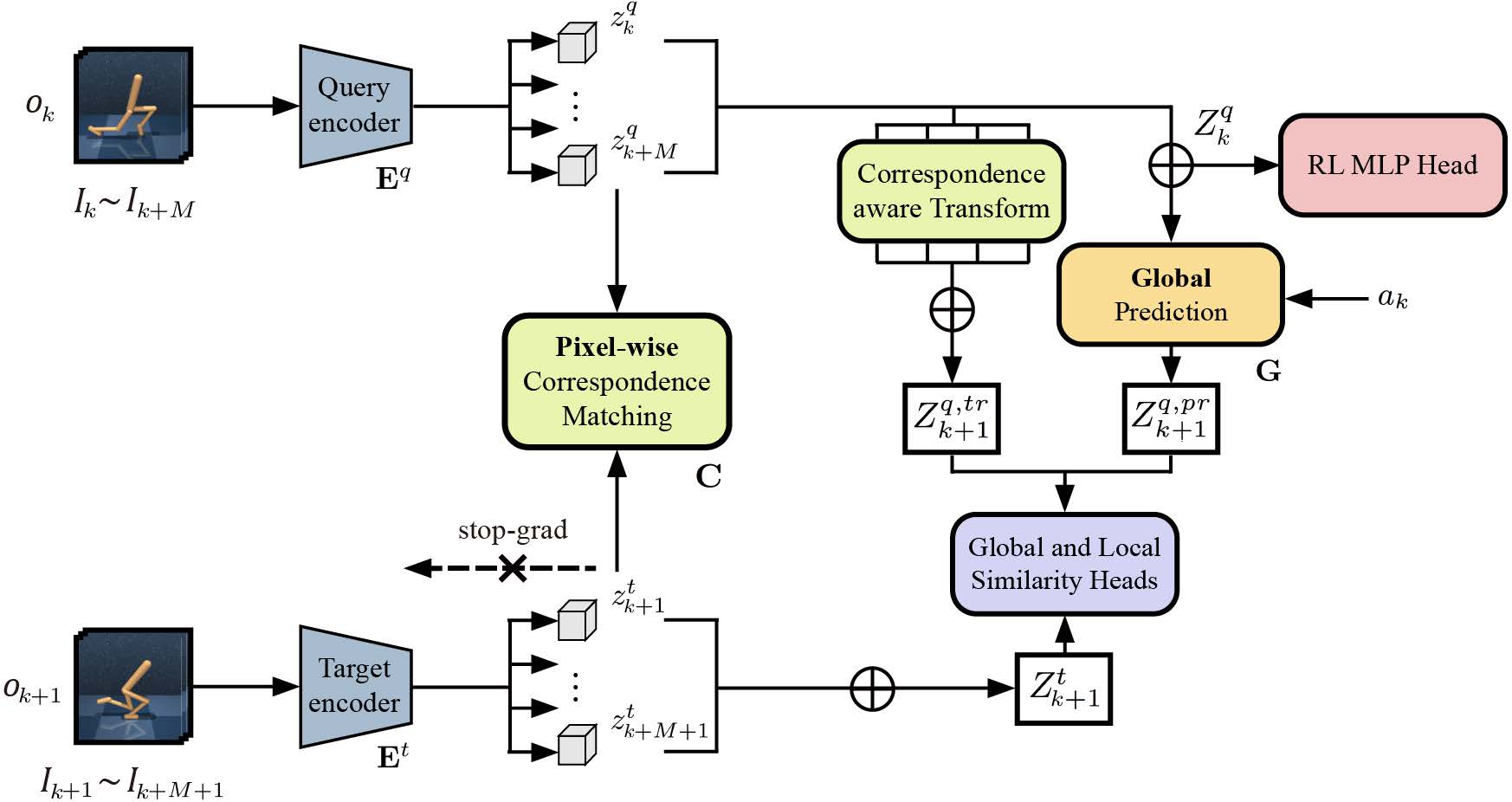
|
abstract |
paper
Recent vision-based reinforcement learning (RL) methods have found extracting high-level features from raw pixels with self-supervised learning to be effective in learning policies. However, these methods focus on learning global representations of images, and disregard local spatial structures present in the consecutively stacked frames. In this paper, we propose a novel approach, termed self-supervised Paired Similarity Representation Learning (PSRL) for effectively encoding spatial structures in an unsupervised manner. Given the input frames, the latent volumes are first generated individually using an encoder, and they are used to capture the variance in terms of local spatial structures, i.e., correspondence maps among multiple frames. This enables for providing plenty of fine-grained samples for training the encoder of deep RL. We further attempt to learn the global semantic representations in the global prediction module that predicts future state representations using action vector as a medium. The proposed method imposes similarity constraints on the three latent volumes; transformed query representations by estimated pixel-wise correspondence, predicted query representations from the global prediction model, and target representations of future state, guiding global prediction with locality-inherent volume. Experimental results on complex tasks in Atari Games and DeepMind Control Suite demonstrate that the RL methods are significantly boosted by the proposed self-supervised learning of structured representations. |
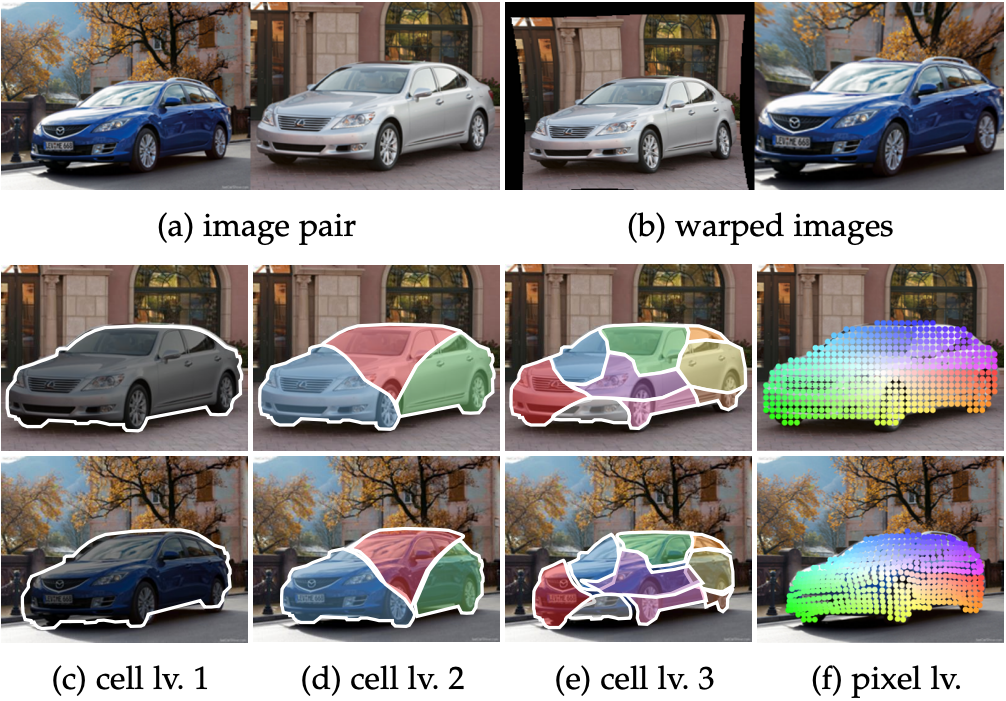
|
abstract |
paper
This paper presents a deep architecture, called pyramidal semantic correspondence networks (PSCNet), that estimates locally-varying affine transformation fields across semantically similar images. To deal with large appearance and shape variations that commonly exist among different instances within the same object category, we leverage a pyramidal model where the affine transformation fields are progressively estimated in a coarse-to-fine manner so that the smoothness constraint is naturally imposed. Different from the previous methods which directly estimate global or local deformations, our method first starts to estimate the transformation from an entire image and then progressively increases the degree of freedom of the transformation by dividing coarse cell into finer ones. To this end, we propose two spatial pyramid models by dividing an image in a form of quad-tree rectangles or into multiple semantic elements of an object. Additionally, to overcome the limitation of insufficient training data, a novel weakly-supervised training scheme is introduced that generates progressively evolving supervisions through the spatial pyramid models by leveraging a correspondence consistency across image pairs. Extensive experimental results on various benchmarks including TSS, Proposal Flow-WILLOW, Proposal Flow-PASCAL, Caltech-101, and SPair-71k demonstrate that the proposed method outperforms the lastest methods for dense semantic correspondence. |
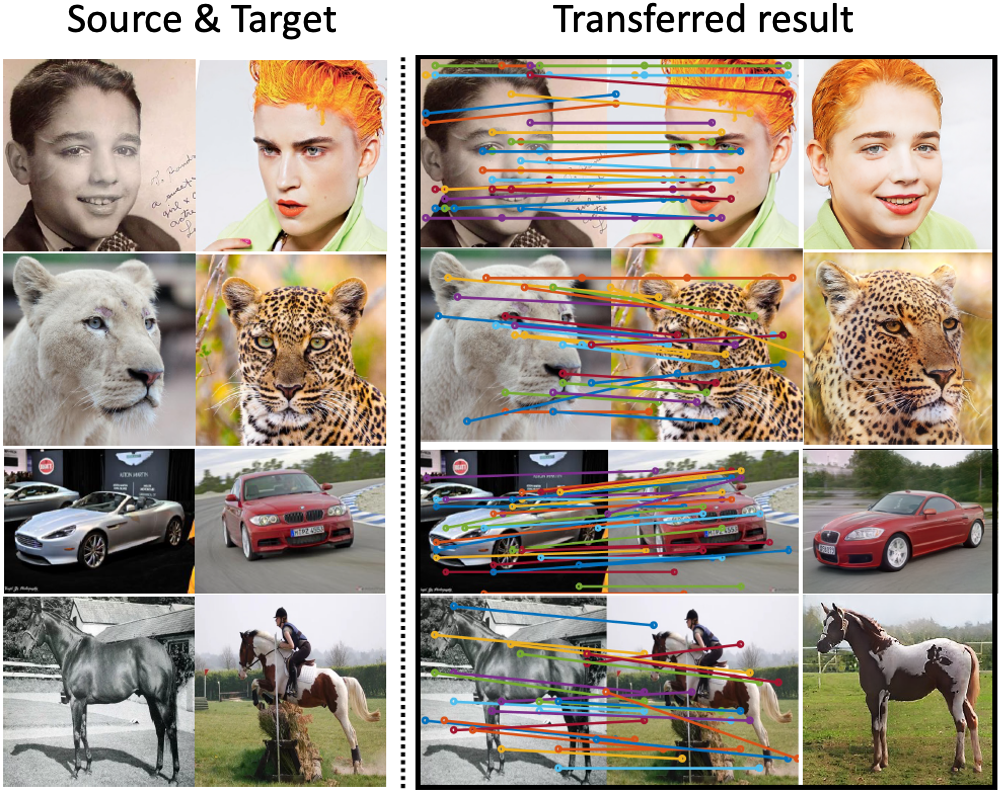
|
abstract |
Semantic correspondence is playing an increasingly important role in photorealistic style transfer, especially on objects with prior structural patterns like faces and cars. Unlike traditional methods that are blind to object/non-object regions and spatial correspondence between objects, we propose a new model called correspondence-driven object appearance transfer (COAT), which leverages correspondence to spatially align texture features to content features at multiple scales. Our model does not require extra supervision like semantic segmentation or body parsing and can be adapted to any given generic object category. More importantly, our multi-scale strategy achieves richer texture transfer, while at the same time preserving the spatial structure of objects in the content image. We further propose the correspondence contrastive loss (CCL) with hard negative mining during the training, boosting appearance transfer with improved disentanglement of structural and textural features. Exhaustive experimental evaluation on various objects demonstrates our superior robustness and visual quality as compared to state-of-the-art works. |
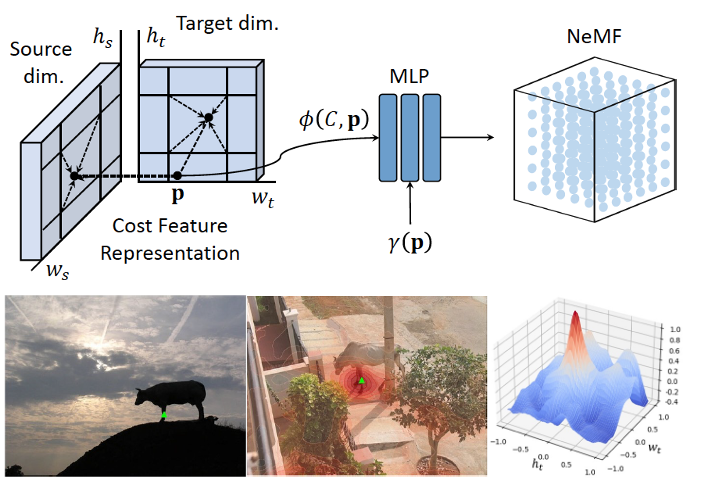
|
abstract |
paper
Existing pipelines of semantic correspondence commonly include extracting high-level semantic features for the invariance against intra-class variations and background clutters. This architecture, however, inevitably results in a low-resolution matching field that additionally requires an ad-hoc interpolation process as a post-processing for converting it into a high-resolution one, certainly limiting the overall performance of matching results. To overcome this, inspired by recent success of implicit neural representation, we present a novel method for semantic correspondence, called neural matching field (NeMF). However, complicacy and high-dimensionality of a 4D matching field are the major hindrances, which we propose a cost embedding network to process a coarse cost volume to use as a guidance for establishing high-precision matching field through the following fully-connected network. Nevertheless, learning a high-dimensional matching field remains challenging mainly due to computational complexity, since a naive exhaustive inference would require querying from all pixels in the 4D space to infer pixel-wise correspondences. To overcome this, we propose adequate training and inference procedures, which in the training phase, we randomly sample matching candidates and in the inference phase, we iteratively performs PatchMatch-based inference and coordinate optimization at test time. With these combined, competitive results are attained on several standard benchmarks for semantic correspondence. |
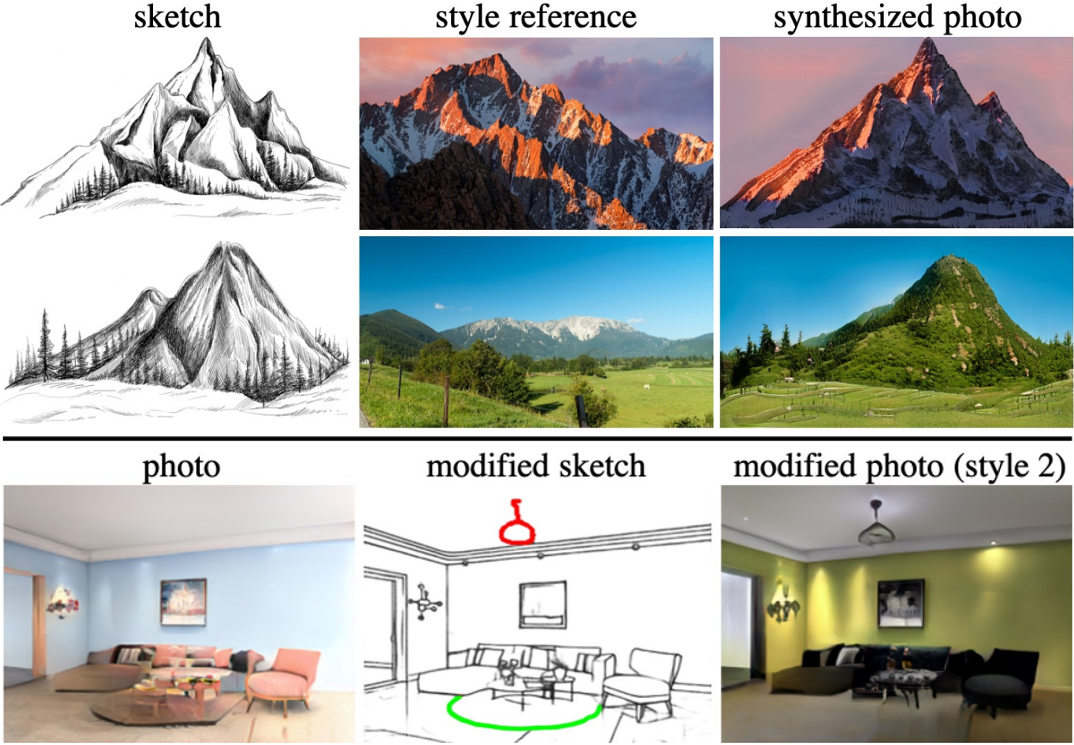
|
abstract |
paper |
media
Sketches make an intuitive and powerful visual expression as they are fast executed freehand drawings. We present a method for synthesizing realistic photos from scene sketches. Without the need for sketch and photo pairs, our framework directly learns from readily available large-scale photo datasets in an unsupervised manner. To this end, we introduce a standardization module that provides pseudo sketch-photo pairs during training by converting photos and sketches to a standardized domain, i.e. the edge map. The reduced domain gap between sketch and photo also allows us to disentangle them into two components: holistic scene structures and low-level visual styles such as color and texture. Taking this advantage, we synthesize a photo-realistic image by combining the structure of a sketch and the visual style of a reference photo. Extensive experimental results on perceptual similarity metrics and human perceptual studies show the proposed method could generate realistic photos with high fidelity from scene sketches and outperform state-of-the-art photo synthesis baselines. We also demonstrate that our framework facilitates a controllable manipulation of photo synthesis by editing strokes of corresponding sketches, delivering more fine-grained details than previous approaches that rely on region-level editing. |
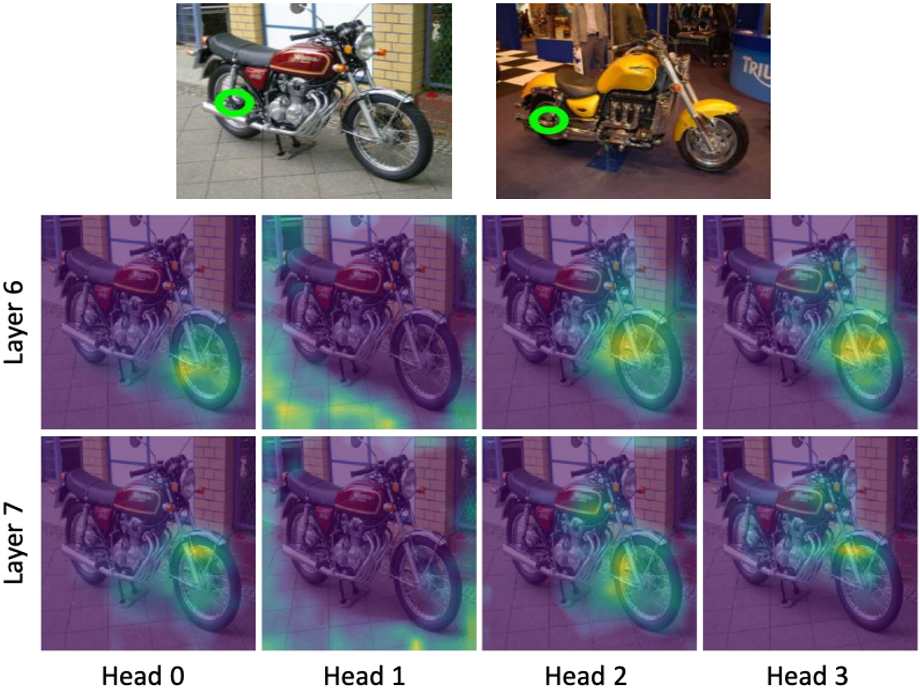
|
abstract |
paper
We propose a novel cost aggregation network, called Cost Aggregation Transformers (CATs), to find dense correspondences between semantically similar images with additional challenges posed by large intra-class appearance and geometric variations. Cost aggregation is a highly important process in matching tasks, which the matching accuracy depends on the quality of its output. Compared to hand-crafted or CNN-based methods addressing the cost aggregation, in that either lacks robustness to severe deformations or inherit the limitation of CNNs that fail to discriminate incorrect matches due to limited receptive fields, CATs explore global consensus among initial correlation map with the help of some architectural designs that allow us to fully leverage self-attention mechanism. Specifically, we include appearance affinity modeling to aid the cost aggregation process in order to disambiguate the noisy initial correlation maps and propose multi-level aggregation to efficiently capture different semantics from hierarchical feature representations. We then combine with swapping self-attention technique and residual connections not only to enforce consistent matching but also to ease the learning process, which we find that these result in an apparent performance boost. We conduct experiments to demonstrate the effectiveness of the proposed model over the latest methods and provide extensive ablation studies. |
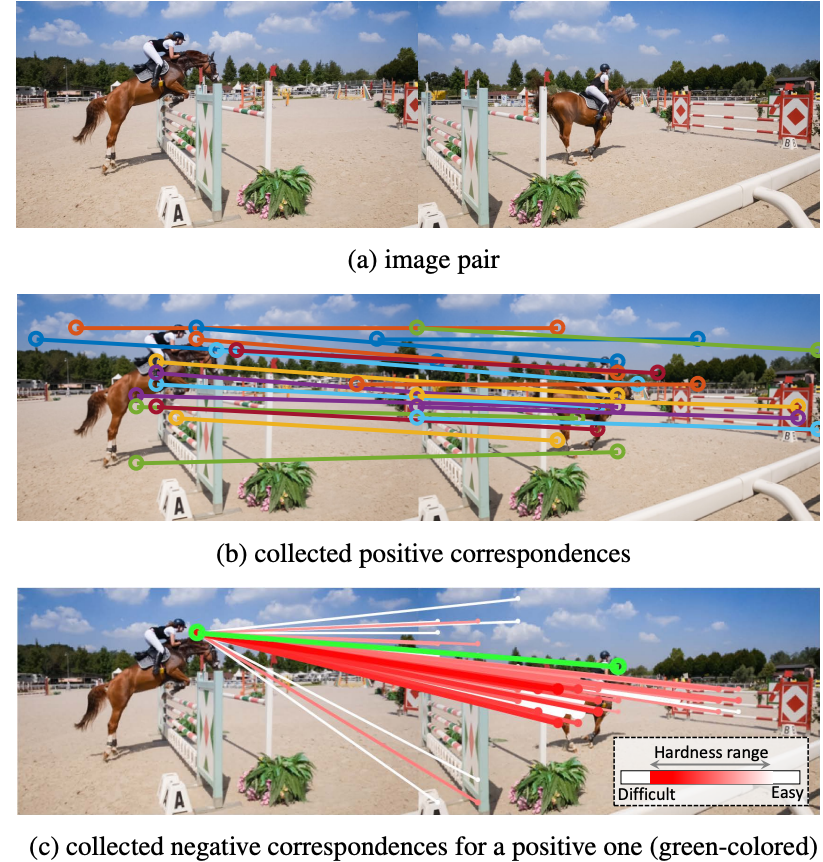
|
abstract |
paper
We present a novel framework for contrastive learning of pixel-level representation using only unlabeled video. Without the need of ground-truth annotation, our method is capable of collecting well-defined positive correspondences by measuring their confidences and well-defined negative ones by appropriately adjusting their hardness during training. This allows us to suppress the adverse impact of ambiguous matches and prevent a trivial solution from being yielded by too hard or too easy negative samples. To accomplish this, we incorporate three different criteria that ranges from a pixel-level matching confidence to a video-level one into a bottom-up pipeline, and plan a curriculum that is aware of current representation power for the adaptive hardness of negative samples during training. With the proposed method, state-of-the-art performance is attained over the latest approaches on several video label propagation tasks. |
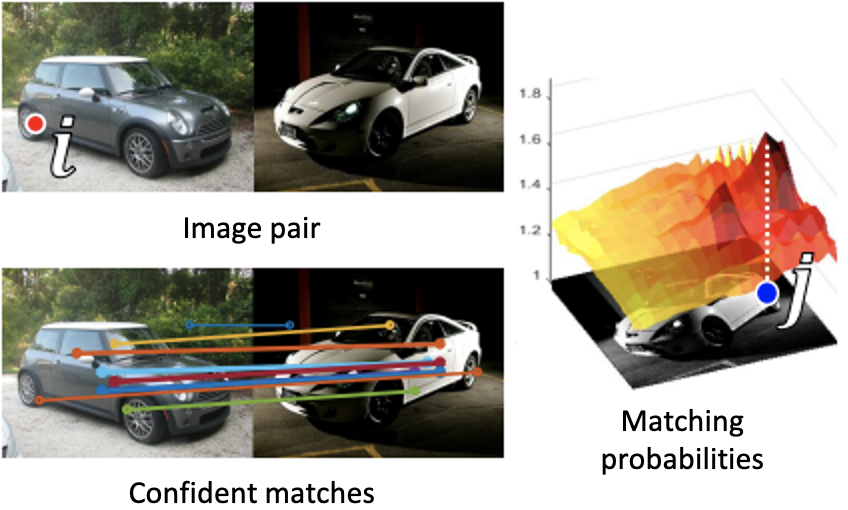
|
abstract |
paper
Establishing dense semantic correspondences requires dealing with large geometric variations caused by the unconstrained setting of images. To address such severe matching ambiguities, we introduce a novel approach, called guided semantic flow, based on the key insight that sparse yet reliable matches can effectively capture non-rigid geometric variations, and these confident matches can guide adjacent pixels to have similar solution spaces, reducing the matching ambiguities significantly. We realize this idea with learning-based selection of confident matches from an initial set of all pairwise matching scores and their propagation by a new differentiable upsampling layer based on moving least square concept. We take advantage of the guidance from reliable matches to refine the matching hypotheses through Gaussian parametric model in the subsequent matching pipeline. With the proposed method, state-of-the-art performance is attained on several standard benchmarks for semantic correspondence. |
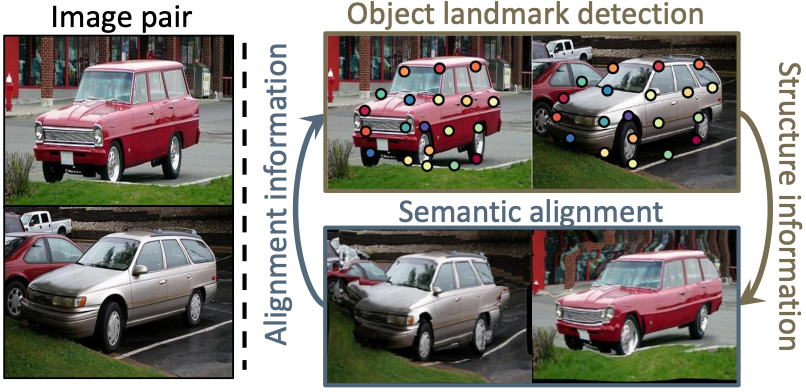
|
abstract |
paper
Convolutional neural networks (CNNs) based approaches for semantic alignment and object landmark detection have improved their performance significantly. Current efforts for the two tasks focus on addressing the lack of massive training data through weakly- or unsupervised learning frameworks. In this paper, we present a joint learning approach for obtaining dense correspondences and discovering object landmarks from semantically similar images. Based on the key insight that the two tasks can mutually provide supervisions to each other, our networks accomplish this through a joint loss function that alternatively imposes a consistency constraint between the two tasks, thereby boosting the performance and addressing the lack of training data in a principled manner. To the best of our knowledge, this is the first attempt to address the lack of training data for the two tasks through the joint learning. To further improve the robustness of our framework, we introduce a probabilistic learning formulation that allows only reliable matches to be used in the joint learning process. With the proposed method, state-of-the-art performance is attained on several benchmarks for semantic matching and landmark detection. |
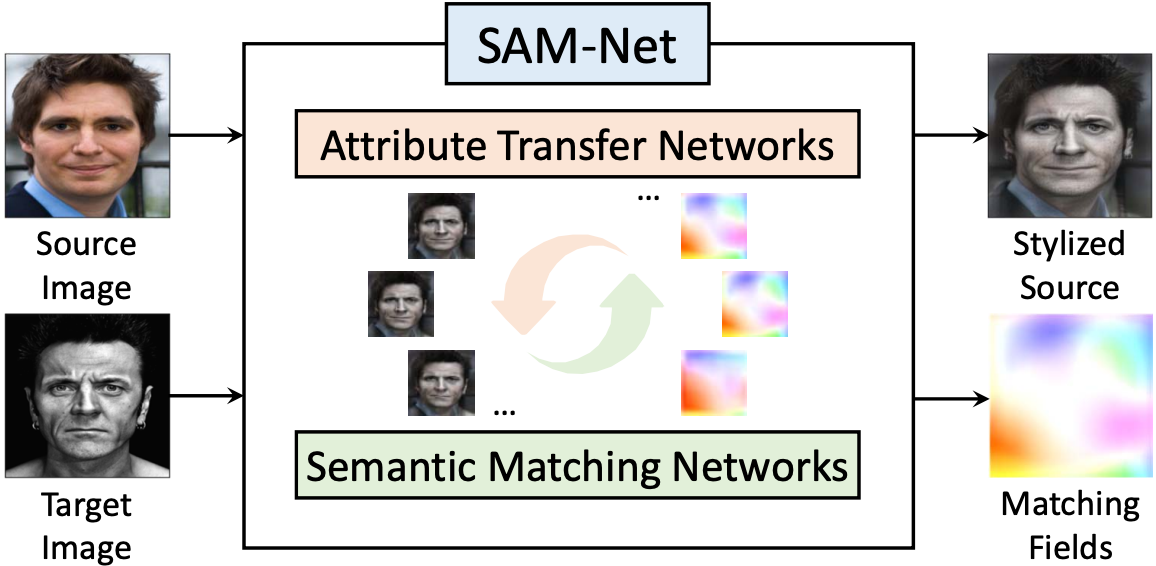
|
abstract |
paper
We present semantic attribute matching networks (SAM-Net) for jointly establishing correspondences and transferring attributes across semantically similar images, which intelligently weaves the advantages of the two tasks while overcoming their limitations. SAM-Net accomplishes this through an iterative process of establishing reliable correspondences by reducing the attribute discrepancy between the images and synthesizing attribute transferred images using the learned correspondences. To learn the networks using weak supervisions in the form of image pairs, we present a semantic attribute matching loss based on the matching similarity between an attribute transferred source feature and a warped target feature. With SAM-Net, the state-of-the-art performance is attained on several benchmarks for semantic matching and attribute transfer. |
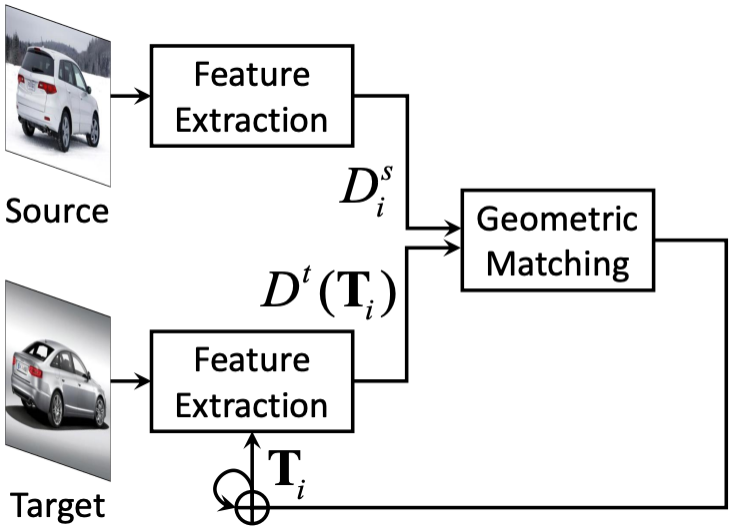
|
abstract |
paper
We present recurrent transformer networks (RTNs) for obtaining dense correspondences between semantically similar images. Our networks accomplish this through an iterative process of estimating spatial transformations between the input images and using these transformations to generate aligned convolutional activations. By directly estimating the transformations between an image pair, rather than employing spatial transformer networks to independently normalize each individual image, we show that greater accuracy can be achieved. This process is conducted in a recursive manner to refine both the transformation estimates and the feature representations. In addition, a technique is presented for weakly-supervised training of RTNs that is based on a proposed classification loss. With RTNs, state-of-the-art performance is attained on several benchmarks for semantic correspondence. |
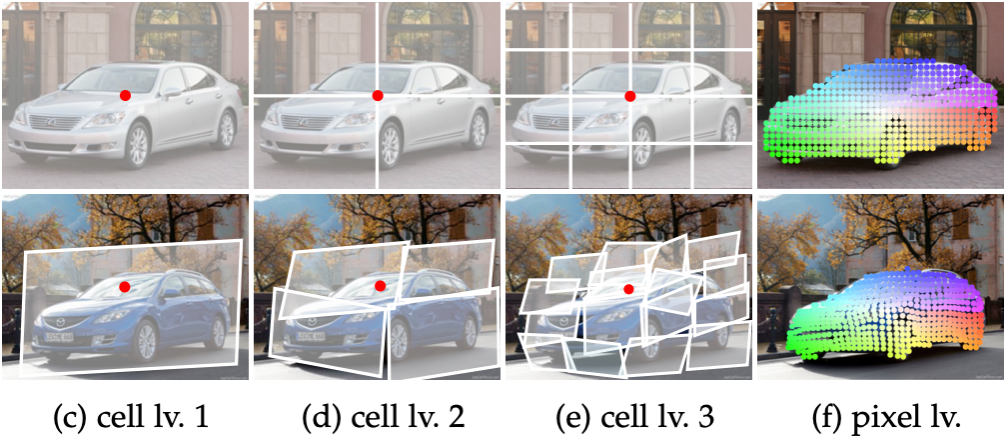
|
abstract |
paper
This paper presents a deep architecture for dense semantic correspondence, called pyramidal affine regression networks (PARN), that estimates locally-varying affine transformation fields across images. To deal with intra-class appearance and shape variations that commonly exist among different instances within the same object category, we leverage a pyramidal model where affine transformation fields are progressively estimated in a coarse-to-fine manner so that the smoothness constraint is naturally imposed within deep networks. PARN estimates residual affine transformations at each level and composes them to estimate final affine transformations. Furthermore, to overcome the limitations of insufficient training data for semantic correspondence, we propose a novel weakly-supervised training scheme that generates progressive supervisions by leveraging a correspondence consistency across image pairs. Our method is fully learnable in an end-to-end manner and does not require quantizing infinite continuous affine transformation fields. To the best of our knowledge, it is the first work that attempts to estimate dense affine transformation fields in a coarse-to-fine manner within deep networks. Experimental results demonstrate that PARN outperforms the state-of-the-art methods for dense semantic correspondence on various benchmarks. |
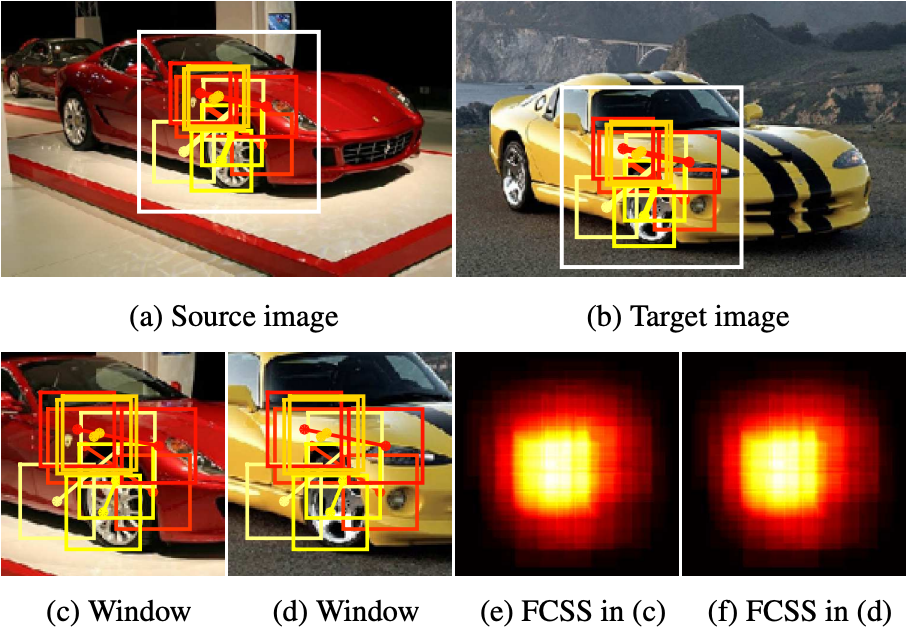
|
abstract |
paper
We present a descriptor, called fully convolutional self-similarity (FCSS), for dense semantic correspondence. To robustly match points among different instances within the same object class, we formulate FCSS using local self-similarity (LSS) within a fully convolutional network. In contrast to existing CNN-based descriptors, FCSS is inherently insensitive to intra-class appearance variations because of its LSS-based structure, while maintaining the precise localization ability of deep neural networks. The sampling patterns of local structure and the self-similarity measure are jointly learned within the proposed network in an end-to-end and multi-scale manner. As training data for semantic correspondence is rather limited, we propose to leverage object candidate priors provided in existing image datasets and also correspondence consistency between object pairs to enable weakly-supervised learning. Experiments demonstrate that FCSS outperforms conventional handcrafted descriptors and CNN-based descriptors on various benchmarks. |
|
Template from this awesome website. |